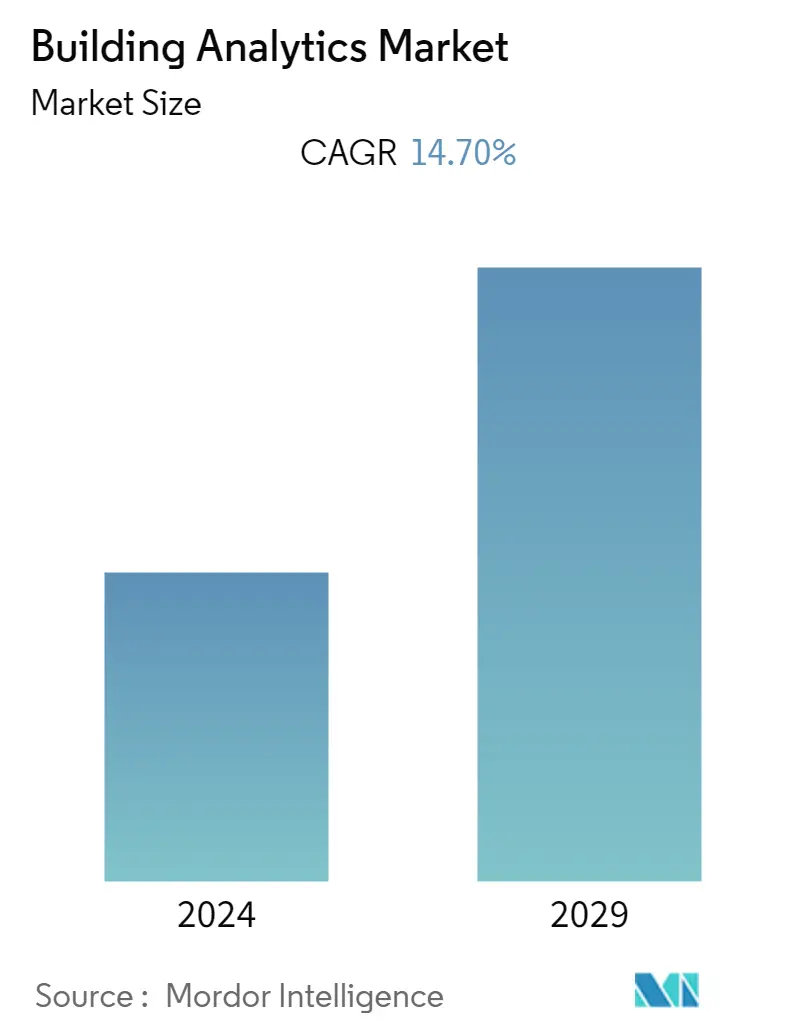Market Size of Building Analytics Industry

| Study Period | 2019 - 2029 |
| Base Year For Estimation | 2023 |
| Forecast Data Period | 2024 - 2029 |
| CAGR | 14.70 % |
| Fastest Growing Market | Asia Pacific |
| Largest Market | Asia Pacific |
Major Players
*Disclaimer: Major Players sorted in no particular order |
Building Analytics Market Analysis
The Building Analytics Market is expected to grow at a CAGR of 14.7% over the forecast period 2021 to 2026. Due to the discernment of business intelligence among emerging countries, demand for building analytics solutions is proliferating. Governments and many vendors are readily investing in technologies in construction services, principally engineering, and architecture. Moreover, an improvement in the adoption of smart building and cloud computing technologies are strengthening the growth of the building analytics market.
- The energy management use is expected to govern the overall building analytics market in terms of share and growth rate, as it is predominantly finding its use in all building facilities to reduce excessive energy consumption across premises. Constant progress in the information & communication technology market owing to innovative efforts have intensified the efficiency of building the analytics market.
- As the world's urban population grows by more than 2.5 billion, primarily to urban areas by 2050, according to MDPI, the construction of new, energy-efficient buildings and cities will be essential to the transformation of the economy. Moreover, the building and construction sector must be decarbonized by 2050 to meet the Paris Agreement's goals.
- The current energy performance of the building sector is weak. In the European Union (EU), with buildings accounting for nearly 40% of its energy consumption, the building sector should play a key role in effective climate policy.
- The trends such as the needs for a variety of buildings value chain (BVC) stakeholders, steadily increasing momentum of big data and their related technologies, combined with AI, namely the new 'engine' of the Fourth Industrial Revolution and IoT infrastructure management enablers constitute a catalyst towards conceptualizing and creating innovative applications and services for energy management and energy-efficient buildings.
- However, the requirement for additional expenditure to avail building analytics services is anticipated to hinder the building analytics market in the next few years. The absence of awareness for building analytics is one of the constraints of the building analytics market.
- Nevertheless, with notable growth in the population across the globe, construction activities are expected to rise substantially. This is projected to generate potential growth possibilities for the building analytics market in the upcoming years.
Building Analytics Industry Segmentation
Building analytics transforms data which is created by the building management system into actionable intelligence. This enables the real-time monitoring, identification, and prioritization of cost-saving opportunities, threats to occupant comfort, connectivity, and mechanical system inefficiencies. Building analytics is based on performance reporting, statistical analysis, and automated diagnosing. It works by using the daily, monthly, and quarterly data for the particularized period and comparing it with history.
| By Application | |
| Energy Management | |
| Security Management | |
| Fault Detection and Monitoring | |
| Other Applications |
| By Component | |
| Software | |
| Services |
| By Deployment Mode | |
| On-Premises | |
| Cloud |
| By Building Type | |
| Residential Buildings | |
| Commercial Buildings | |
| Other Building Types |
| Geography | |
| North America | |
| Europe | |
| Asia Pacific | |
| Latin America | |
| Middle East and Africa |
Building Analytics Market Size Summary
The Building Analytics Market is experiencing significant growth, driven by the increasing adoption of smart building and cloud computing technologies. This market is characterized by the integration of advanced data processing methods and the use of big data, AI, and IoT to enhance energy management and improve energy efficiency in buildings. The demand for building analytics solutions is particularly strong in emerging economies, where governments and vendors are investing heavily in construction technologies. The market is also influenced by the need to decarbonize the building sector to meet global climate goals, as buildings account for a substantial portion of energy consumption. Despite the potential hindrances posed by the need for additional expenditure and a lack of awareness, the market is poised for growth due to the rising global population and subsequent increase in construction activities.
In the Asia Pacific region, the building analytics market is expected to grow at a rapid pace, fueled by substantial economic growth and significant governmental investments in the manufacturing and construction sectors. Countries like China, India, and Japan are leading the charge in adopting building analytics solutions, driven by the need for energy-efficient buildings and smart infrastructure. The market is moderately competitive, with major players like Schneider Electric, IBM Corporation, and Honeywell dominating the landscape. These companies are continuously innovating and expanding their presence through strategic developments, such as Siemens' integration of energy monitoring software into building management systems and Honeywell's launch of enterprise performance management software. These advancements are crucial for enhancing the efficiency and sustainability of building operations globally.
Building Analytics Market Size - Table of Contents
-
1. MARKET DYNAMICS
-
1.1 Market Overview
-
1.2 Market Drivers
-
1.2.1 Increased Demand for Energy-Efficient Systems
-
1.2.2 Growing Adoption of Cloud-Based IoT Platforms
-
-
1.3 Market Restraints
-
1.3.1 High Cost of Implementation
-
-
1.4 Industry Attractiveness - Porter's Five Force Analysis
-
1.4.1 Threat of New Entrants
-
1.4.2 Bargaining Power of Buyers/Consumers
-
1.4.3 Bargaining Power of Suppliers
-
1.4.4 Threat of Substitute Products
-
1.4.5 Intensity of Competitive Rivalry
-
-
1.5 Industry Value Chain Analysis
-
1.6 Assessment of Impact of Covid-19 on the Industry
-
-
2. MARKET SEGMENTATION
-
2.1 By Application
-
2.1.1 Energy Management
-
2.1.2 Security Management
-
2.1.3 Fault Detection and Monitoring
-
2.1.4 Other Applications
-
-
2.2 By Component
-
2.2.1 Software
-
2.2.2 Services
-
-
2.3 By Deployment Mode
-
2.3.1 On-Premises
-
2.3.2 Cloud
-
-
2.4 By Building Type
-
2.4.1 Residential Buildings
-
2.4.2 Commercial Buildings
-
2.4.3 Other Building Types
-
-
2.5 Geography
-
2.5.1 North America
-
2.5.2 Europe
-
2.5.3 Asia Pacific
-
2.5.4 Latin America
-
2.5.5 Middle East and Africa
-
-
Building Analytics Market Size FAQs
What is the current Building Analytics Market size?
The Building Analytics Market is projected to register a CAGR of 14.70% during the forecast period (2024-2029)
Who are the key players in Building Analytics Market?
Schneider Electric , IBM Corporation, Johnson Controls International PLC, Honeywell International Inc. and Siemens AG are the major companies operating in the Building Analytics Market.

